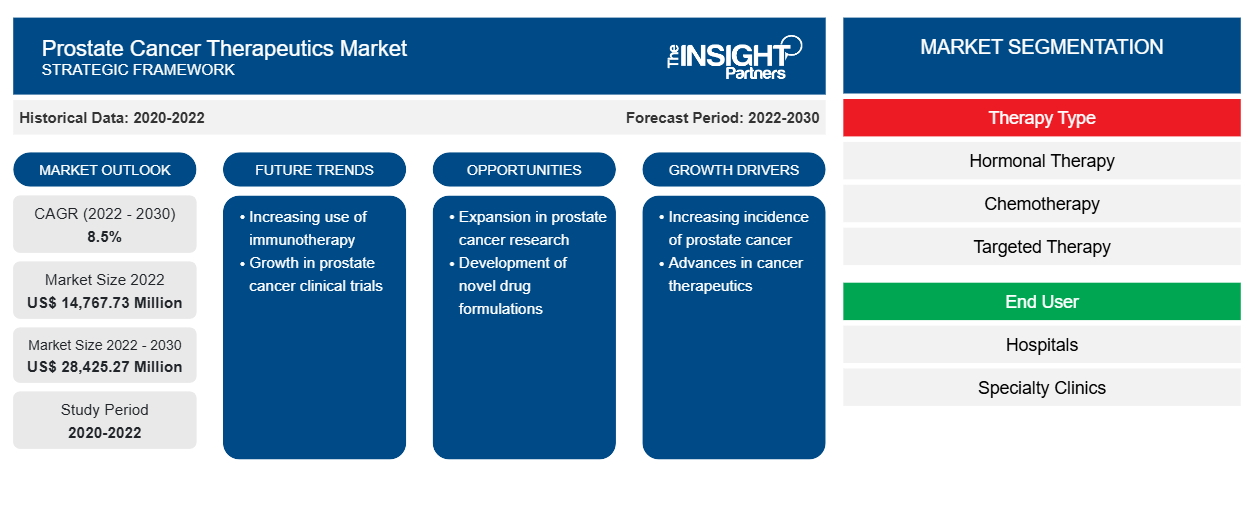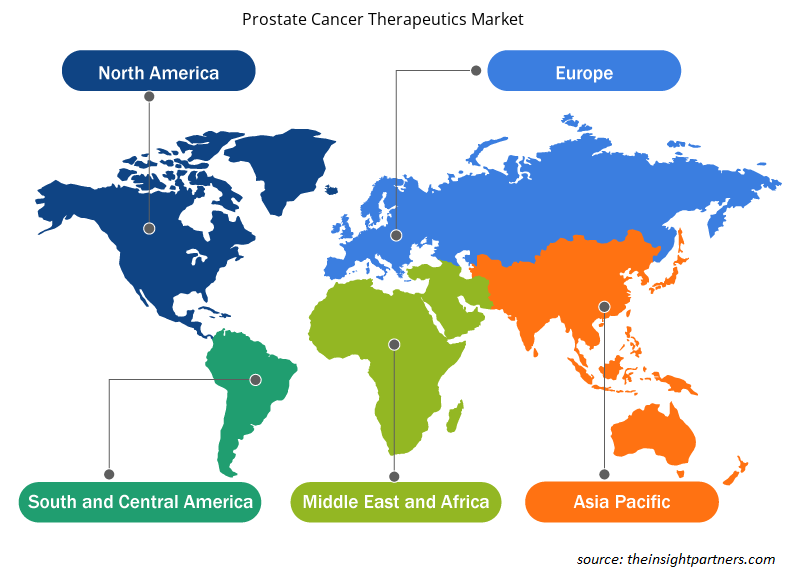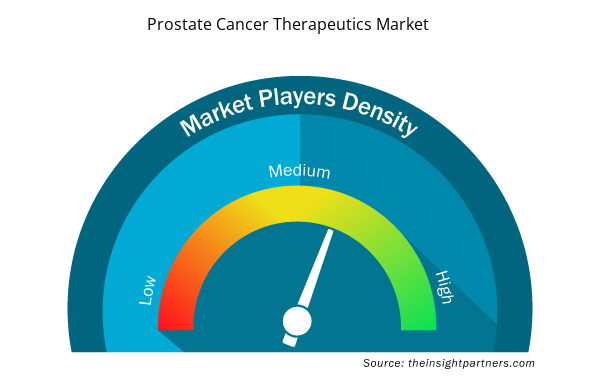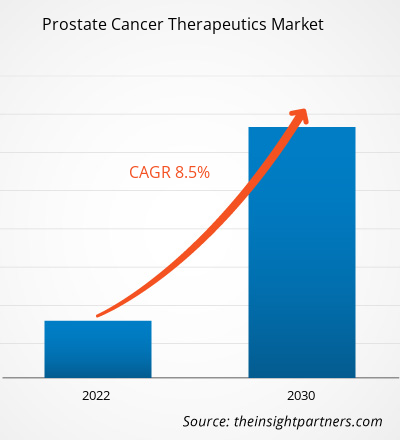[Research Report] The prostate cancer therapeutics market is expected to grow from US$ 14,767.73 million in 2022 to US$ 28,425.27 million by 2030; it is anticipated to record a CAGR of 8.5% from 2022 to 2030.
Market Insights and Analyst View:
The prostate cancer therapeutics market size is expanding with the rising R&D activities to introduce new drug compounds, increasing number of prostate cancer cases, and rising government support for diagnostics of prostate cancer. In addition, market players' availability of advanced products drives market growth. In January 2023, BDR Pharmaceutical launched a generic version of Apalutamide that is used to treat prostate cancer in India. The drug is launched under the brand APATIDE and is prescribed to treat non-metastatic castration-resistant prostate cancer and metastatic castration-sensitive prostate cancer.
Growth Drivers and Challenges:
Prostate cancer is one of the most common health problems in men, especially in older men aged 50 years and above. Prostate cancer is mostly common in men who are obese and have a family history of prostate cancer. Prostate cancer is a silent threat as it often develops without noticeable symptoms. Hence, early detection of this cancer is not that easy. The majority of prostate cancers originate in the peripheral region of the prostate gland. For symptoms to become apparent, the cancer must reach a size where it exerts pressure on the urethra, or bone pain from the metastasis might be the initial presenting symptom of advanced prostate cancer in some cases. However, any individual aged 50 or above who presents with lower urinary tract symptoms, erectile dysfunction, or hematuria should consider the possibility of prostate cancer. Prostate cancer is the fifth leading cause of cancer death among men across the world and the second most commonly diagnosed cancer. Even if there has been a decrease in the incidence of prostate cancer since 2000, there is an increase in the incidence of later-stage prostate cancer starting in 2010. Prostate cancer incidence rates and mortality rates differ greatly. Developed nations generally have a higher incidence of prostate cancer but lower mortality. The risk of prostate cancer in the US is almost four times greater than the global risk. According to the Novartis AG, in 2020, ~1.4 million new prostate cancer cases and about 375,000 prostate cancer deaths were reported worldwide. The increasing number of prostate cancer cases worldwide and the low detection rate of prostate cancer fuel the prostate cancer therapeutics market growth.
Customize This Report To Suit Your Requirement
You will get customization on any report - free of charge - including parts of this report, or country-level analysis, Excel Data pack, as well as avail great offers and discounts for start-ups & universities
Prostate Cancer Therapeutics Market: Strategic Insights

- Get Top Key Market Trends of this report.This FREE sample will include data analysis, ranging from market trends to estimates and forecasts.
Customize This Report To Suit Your Requirement
You will get customization on any report - free of charge - including parts of this report, or country-level analysis, Excel Data pack, as well as avail great offers and discounts for start-ups & universities
Prostate Cancer Therapeutics Market: Strategic Insights

- Get Top Key Market Trends of this report.This FREE sample will include data analysis, ranging from market trends to estimates and forecasts.
Report Segmentation and Scope:
The prostate cancer therapeutics market is segmented based on therapy type, end user, and geography. The prostate cancer therapeutics market, by therapy type, is segmented into hormone therapy, chemotherapy, immunotherapy, targeted therapy, and others. The prostate cancer therapeutics market, by end user, is segmented into hospitals, specialty clinics, and others. Based on geography, the prostate cancer therapeutics market is segmented into North America (the US, Canada, and Mexico), Europe (the UK, Germany, France, Italy, Spain, and the Rest of Europe), Asia Pacific (China, Japan, India, South Korea, Australia, and the Rest of Asia Pacific), the Middle East & Africa (the UAE, Saudi Arabia, South Africa, and the Rest of Middle East & Africa), and South & Central America (Brazil, Argentina, and the Rest of South & Central America).
Segmental Analysis:
The prostate cancer therapeutics market, by therapy type, is segmented into hormone therapy, chemotherapy, immunotherapy, targeted therapy, and others. In 2022, the Hormone therapy segment held the largest market share after chemo therapy, and the same segment is expected to record the highest CAGR from 2022 to 2030. Chemotherapy is considered an important treatment for prostate cancer. In this therapy, drugs destroy the new or existing cancerous cells in the lungs. Chemotherapy for metastatic prostate cancer can alleviate symptoms. It can also help to reduce cancer and improve the quality of life. Docetaxel (Taxotere) is considered the standard of care in prostate cancer chemotherapy in patients who are resistant to hormone therapy. The FDA has also approved the chemotherapy drug cabazitaxel (Jevtana) for treating castration-resistant prostate cancer. It is also used for patients affected by metastatic prostate cancer that has grown while taking docetaxel.
Regional Analysis:
The prostate cancer therapeutics market is segmented geographically into North America, Europe, Asia Pacific, the Middle East & Africa, and South & Central America. North America is the largest contributor to global prostate cancer therapeutics market growth. Asia Pacific is expected to register the highest CAGR in the prostate cancer therapeutics market from 2022 to 2030. The prostate cancer therapeutics market growth in the US is mainly driven by the increasing incidence of prostate cancer cases, product launches, and government initiatives. In June 2023, AstraZeneca and MSD’s Lynparza (olaparib) in combination with prednisone or prednisolone and abiraterone was approved in the US to treat adult patients with suspected deleterious BRCA-mutated (BRCAm) metastatic castration-resistant prostate cancer (mCRPC). In addition, in November 2023, the FDA approved enzalutamide, a product that Astellas Pharma US, Inc. manufactured. The product is used for the treatment of non-metastatic castration-sensitive prostate cancer (nmCSPC) with biochemical recurrence at high risk for metastasis (high-risk BCR).
Prostate Cancer Therapeutics Market Regional Insights
Prostate Cancer Therapeutics Market Regional Insights
The regional trends and factors influencing the Prostate Cancer Therapeutics Market throughout the forecast period have been thoroughly explained by the analysts at Insight Partners. This section also discusses Prostate Cancer Therapeutics Market segments and geography across North America, Europe, Asia Pacific, Middle East and Africa, and South and Central America.

- Get the Regional Specific Data for Prostate Cancer Therapeutics Market
Prostate Cancer Therapeutics Market Report Scope
| Report Attribute | Details |
|---|---|
| Market size in 2022 | US$ 14,767.73 Million |
| Market Size by 2030 | US$ 28,425.27 Million |
| Global CAGR (2022 - 2030) | 8.5% |
| Historical Data | 2020-2022 |
| Forecast period | 2022-2030 |
| Segments Covered |
By Therapy Type
|
| Regions and Countries Covered | North America
|
| Market leaders and key company profiles |
Prostate Cancer Therapeutics Market Players Density: Understanding Its Impact on Business Dynamics
The Prostate Cancer Therapeutics Market market is growing rapidly, driven by increasing end-user demand due to factors such as evolving consumer preferences, technological advancements, and greater awareness of the product's benefits. As demand rises, businesses are expanding their offerings, innovating to meet consumer needs, and capitalizing on emerging trends, which further fuels market growth.
Market players density refers to the distribution of firms or companies operating within a particular market or industry. It indicates how many competitors (market players) are present in a given market space relative to its size or total market value.
Major Companies operating in the Prostate Cancer Therapeutics Market are:
- Astella Pharma Inc
- Johnson & Johnson Services Inc
- Eli Lilly, and Company
- Bayer AG
- Sanofi
Disclaimer: The companies listed above are not ranked in any particular order.

- Get the Prostate Cancer Therapeutics Market top key players overview
Industry Developments and Future Opportunities:
Various initiatives by key players operating in the prostate cancer therapeutics market are listed below:
- In March 2022, the US FDA approved Novartis’s Pluvicto (lutetium Lu 177 vipivotide tetraxetan) for treating adult patients with a type of advanced prostate cancer called prostate-specific membrane antigen-positive metastatic castration-resistant prostate cancer (PSMA-positive mCRPC).
- In April 2023, the FDA granted Lantheus Holdings Inc and POINT Biopharma Global Inc fast track designation for 177Lu-PNT2002 for treating metastatic castration-resistant prostate cancer (mCRPC). PNT2002 is an innovative PSMA-targeted 177Lu-based radiopharmaceutical therapy that combines PSMA-targeted ligand, PSMA-I&T, and beta-emitting radioisotope no-carrier-added 177Lu for treating mCRPC.
Competitive Landscape and Key Companies:
Astella Pharma Inc, Johnson & Johnson Services Inc, Eli Lilly and Company, Bayer AG, Sanofi, Merck KGaA, AstraZeneca, Novartis AG, AbbVie, and Bristol Myers Squibb are among the prominent players operating in the prostate cancer therapeutics market. These market players focus on new product launches and geographic expansions to fulfill the growing consumer demand worldwide and increase their product range in specialty portfolios. Their global presence allows them to serve a large base of customers, subsequently facilitating market expansion.
- Historical Analysis (2 Years), Base Year, Forecast (7 Years) with CAGR
- PEST and SWOT Analysis
- Market Size Value / Volume - Global, Regional, Country
- Industry and Competitive Landscape
- Excel Dataset



Report Coverage
Revenue forecast, Company Analysis, Industry landscape, Growth factors, and Trends

Segment Covered
Therapy Type, End User, and Geography

Regional Scope
North America, Europe, Asia Pacific, Middle East & Africa, South & Central America

Country Scope
This text is related
to country scope.
Frequently Asked Questions
Based on geography, the prostate cancer therapeutics market is segmented into North America (the US, Canada, and Mexico), Europe (the UK, Germany, France, Italy, Spain, and the Rest of Europe), Asia Pacific (China, Japan, India, South Korea, Australia, and the Rest of Asia Pacific), the Middle East & Africa (the UAE, Saudi Arabia, South Africa, and Rest of the Middle East & Africa), and South & Central America (Brazil, Argentina, and the Rest of South & Central America). North America is the largest contributor to global prostate cancer therapeutics market growth. Asia Pacific is expected to register the highest CAGR in the prostate cancer therapeutics market from 2022 to 2030.
The prostate cancer therapeutics market, by therapy type, is segmented into hormone therapy, chemotherapy, immunotherapy, targeted therapy, and others. In 2022, the chemotherapy segment held the largest market share, and the same segment is expected to record the highest CAGR from 2022 to 2030.
The prostate cancer therapeutics market, by end-user, is segmented into hospitals, specialty clinics, and others. In 2022, the hospital segment held the largest market share; moreover, the same segment is expected to record the highest CAGR during 2022–2030.
The increasing cases of prostate cancer and strategic initiatives in prostate cancer therapeutics freezer bolster the prostate cancer therapeutics market size. However, the high cost associated with prostate cancer therapeutics hinders the growth of prostate cancer therapeutics market growth.
The prostate cancer therapeutics market majorly consists of players such Astella Pharma Inc, Johnson & Johnson Services Inc, Eli Lilly and Company, Bayer AG, Sanofi, Merck KGaA, AstraZeneca, Novartis AG, AbbVie, and Bristol Myers Squibb
Prostate cancer is one of the most common health problems in men, especially in older men (aged above 50 years). Prostate cancer is mostly common in men who are obese and have a family history of prostate cancer. Prostate cancer is a silent threat that often develops without noticeable symptoms, and hence, early detection of this cancer is not that easy. Typically, the majority of prostate cancers originate in the peripheral region of the prostate gland. Consequently, for symptoms to become apparent, the cancer must reach a size where it exerts pressure on the urethra, or in some cases, bone pain from the metastasis might be the initial presenting symptom of advanced prostate cancer. However, any individual aged 50 or above who presents with lower urinary tract symptoms, erectile dysfunction, or hematuria should consider the possibility of prostate cancer.
Trends and growth analysis reports related to Life Sciences : READ MORE..
The List of Companies - Prostate Cancer Market
- Astella Pharma Inc
- Johnson & Johnson Services Inc
- Eli Lilly, and Company
- Bayer AG
- Sanofi
- Merck KGaA
- AstraZeneca
- Novartis AG
- AbbVie
- Bristol Myers Squibb

 Get Free Sample For
Get Free Sample For